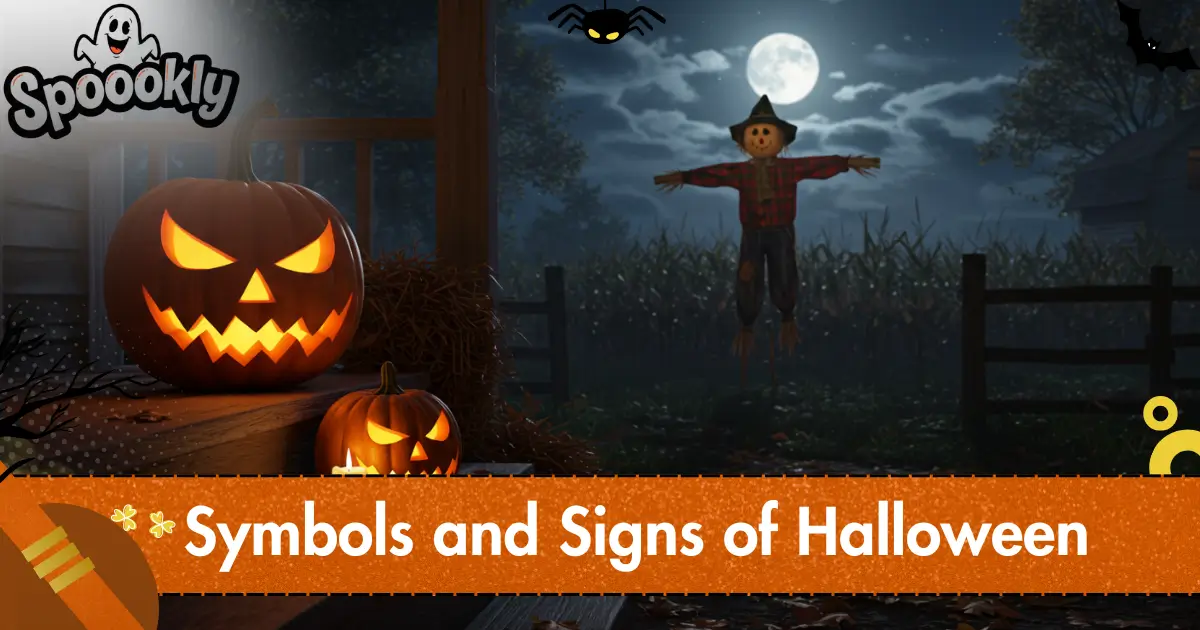Halloween is a night of costumes and candy. It’s a powerful celebration steeped in history, mystery, and centuries of tradition.
From flickering jack-o’-lanterns to haunted houses, every spooky detail has a deeper meaning. These symbols didn’t appear out of nowhere, they come from ancient beliefs, folklore, and cultural evolution.
In this article, I’ll discuss the powerful symbols and signs of Halloween, explain their origins, and show how they’ve shaped today’s Halloween traditions. Whether you love decorating your porch with pumpkins or dressing up as a witch, knowing the background makes it all the more fascinating.
Let’s take a closer look at where it all began.
Historical Roots of Halloween
Halloween’s Ancient Origins in Samhain
Halloween traces its roots to the Celtic festival of Samhain (pronounced sow-in). It marked the end of the harvest season and the beginning of the darker half of the year.
Celebrated from October 31st to November 1st, Samhain was a time when people believed the veil between the living and the dead was thin. Spirits could cross into the mortal world.
To protect themselves, people lit bonfires and wore masks or costumes, a practice known as “guising”. The goal? Confuse or scare away wandering spirits.
Communities in regions like modern-day Ireland, Scotland, and parts of Britain took part in these rituals. These traditions form the foundation of many modern Halloween customs.
From Samhain to All Hallows’ Eve
As Christianity spread across Europe, church leaders rebranded pagan festivals to align with Christian teachings. In the 8th century, Pope Gregory III declared November 1st as All Saints’ Day, also called All Hallows’ Day. The night before became known as All Hallows’ Eve, which later evolved into “Halloween.”
This blending of traditions helped preserve some older practices while incorporating new meanings. The spiritual significance remained strong but now with saints, martyrs, and spirits of the faithful added to the mix.
How Halloween Evolved in Modern Times
When Irish immigrants came to North America in the 19th century, they brought Halloween with them. In the United States, Halloween gained popularity rapidly, especially by the early 20th century.
By the 1950s, it became a widespread cultural celebration, marked by costumes, trick-or-treating, parties, and spooky decorations.
Commercialization followed quickly. Stores began to sell Halloween candy, decor, and costumes. Over time, this once-sacred night transformed into the festive event we know today but many of its ancient symbols still remain.
Evolution of Halloween
| Period | Key Features | Influence on Today’s Halloween |
|---|---|---|
| Samhain (Celtic) | Harvest end, spirits crossing over, bonfires, guising | Costumes, spirit-themed decorations |
| Christian Era | All Hallows’ Eve, honoring saints and souls | Religious undertones, remembrance themes |
| 19th Century | Irish-American fusion, ghost stories | Trick-or-treat, pumpkins, folklore |
| 1950s–Present | Commercial rise, pop culture integration | Halloween parties, marketing, costumes |
Classic Symbols and Their Meanings
Halloween wouldn’t be what it is without its timeless symbols. Each has a rich backstory, steeped in folklore, culture, and spiritual meaning. Let me walk you through the most iconic Halloween symbols and how they’ve evolved over time.
1. Jack‑o’‑Lantern (Pumpkin) 🎃
The glowing jack-o’-lantern is Halloween’s most recognized icon. But it started far from today’s carved pumpkins.
In ancient Ireland, people carved turnips and placed hot coals inside them. This tradition came from the folktale of Stingy Jack, a man who tricked the Devil and was doomed to wander Earth with only a burning coal in a hollowed vegetable. These lanterns were placed outside to ward off evil spirits and lost souls.
Once Irish immigrants reached America, they found pumpkins larger and easier to carve. The tradition quickly adapted.
Today, jack-o’-lanterns light up porches and front yards. They symbolize protection, creativity, and seasonal change.
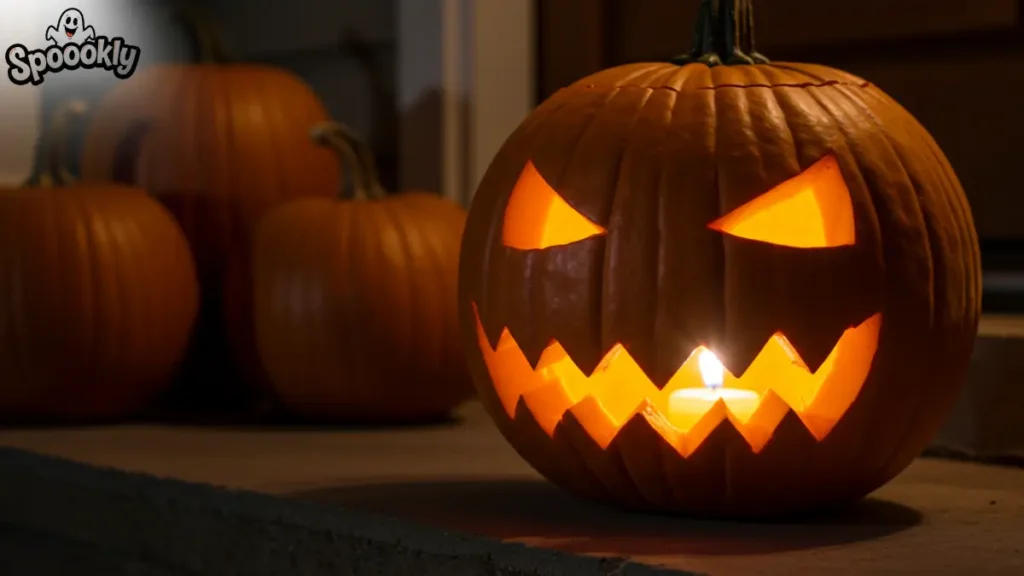
2. Witches & Witches Marks 🧙
No Halloween scene is complete without a witch flying past a full moon. The witch’s silhouette, pointed hat, broomstick, and cauldron are instantly recognizable. But where did it all come from?
During the Middle Ages, women who practiced herbalism or natural healing were branded as witches. Their image became tied to fear, mystery, and power. The pointed hat may have originated from tall headgear worn in Eastern Europe, and the broomstick symbolized domestic work turned magical.
Witches’ marks symbols like daisy wheels and pentagrams were carved into door frames to ward off evil. These marks are called apotropaic symbols.
Today, witches stand for both mystery and empowerment. Their image is popular in costumes, decor, and pop culture.
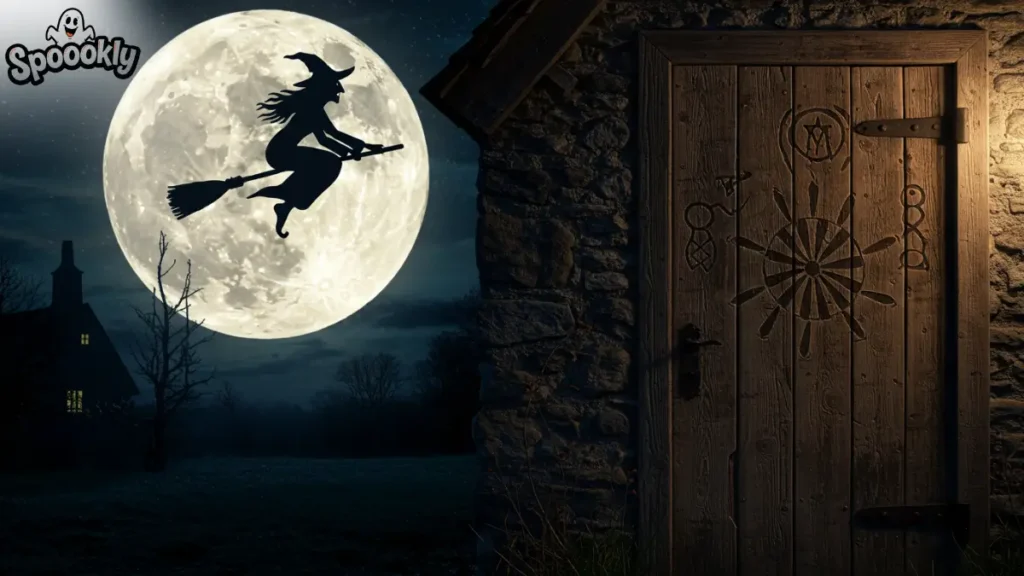
3. Ghosts & Spirits 👻
Halloween is deeply connected to the spirit world. During Samhain, the belief was that spirits of the dead returned to visit the living. People lit candles and left out food offerings to welcome or ward them off.
The classic image of a white-sheet ghost came from Victorian burial practices and 19th-century ghost stories.
Ghosts represent the fear of the unknown, loss, and remembrance. Their presence in Halloween decor like floating figures or haunted sounds helps us connect with themes of life, death, and what lies beyond.
4. Skeletons & Skulls 💀
Skeletons are perhaps the most universal symbol of death. They’ve been used in medieval art like the danse macabre, a visual reminder that death comes for everyone.
In modern culture, skeletons are used both for fun and fear. Their grinning faces appear on costumes, yard props, and even candy. In Latin America, Day of the Dead celebrations honor skeletons as joyful symbols of remembrance.
The skull, in particular, stands for mortality, but it’s also seen as a symbol of transformation and inner truth.
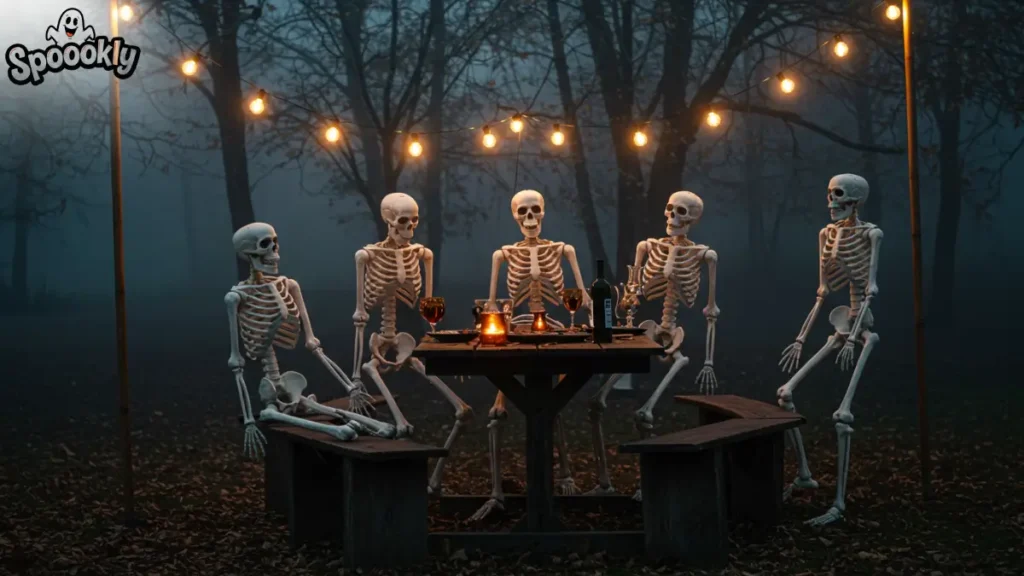
5. Black Cats & Bats
Black cats have long been tied to witchcraft and bad luck. In the Middle Ages, people believed cats were witches’ familiars, animal companions with magical powers. Seeing a black cat cross your path was thought to bring misfortune.
Bats are nocturnal, mysterious, and linked to darkness and blood. Their connection to vampires comes from folklore about vampire bats and their silent flight.
Today, these creatures are Halloween staples. Whether printed on napkins or lurking in yard displays, they add to the eerie atmosphere.
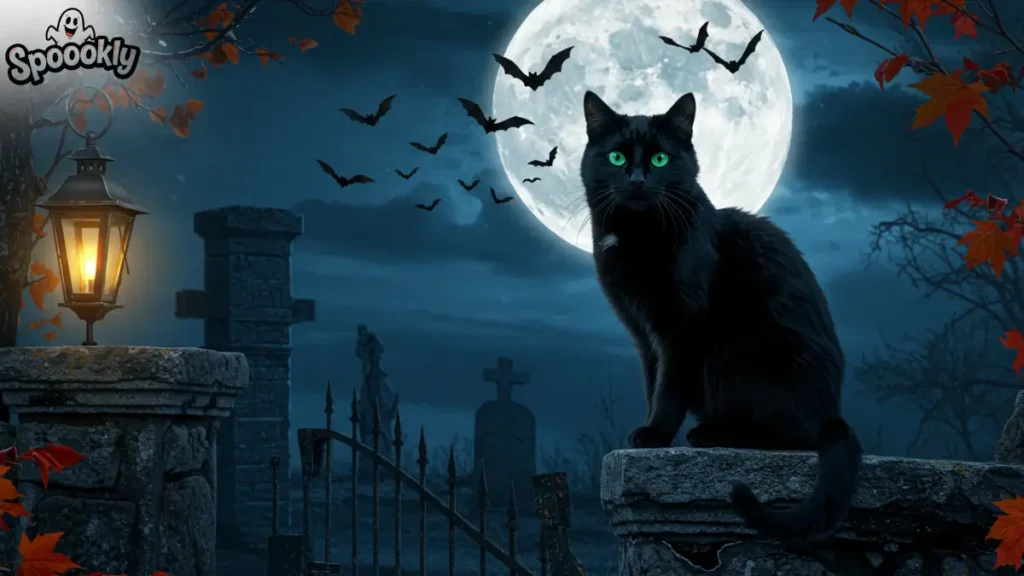
6. Spiders & Cobwebs
Spiders may be small, but their symbolism is huge. In ancient cultures, spiders were seen as weavers of fate and time. Their webs suggest patience, mystery, and hidden danger.
In Halloween decor, cobwebs are used to signal decay, age, and abandonment. They turn any space into something haunted.
You’ll find toy spiders, stretchable webs, and even light-up decorations used to give a place that creepy old feel.
7. Scarecrows, Corn & Harvest Symbols
Halloween’s ties to autumn are seen in scarecrows, corn husks, and hay bales. These symbols go back to Halloween’s agrarian roots, when the end of harvest marked a sacred time.
Scarecrows once protected crops, but now they add a rustic and eerie charm to Halloween setups. Paired with pumpkins and pitchforks, they celebrate the transition from life to rest from summer to winter.
8. Haunted Houses & Graveyards
Few things are more associated with Halloween than a haunted house or graveyard. These symbols touch our deepest fears; the unknown, the supernatural, and death.
In older traditions, graveyards represented soul transitions and the space between life and the afterlife. Haunted houses symbolized restless spirits unable to move on.
Today, haunted attractions are big business. From ghost tours to walk-through horror experiences, people willingly step into fear for the thrill of it.

Overview of Halloween Symbols and Their Meanings
| Symbol | Origin | Meaning | Modern Use |
|---|---|---|---|
| Jack-o’-lantern | Irish folktale (Stingy Jack) | Warding off evil spirits | Pumpkin carving, porch décor |
| Witches | Medieval Europe | Magic, fear, resistance | Costumes, decorations, pop culture |
| Ghosts | Samhain, Victorian era | Spirits, memory, mystery | Floating props, white-sheet ghosts |
| Skeletons/Skulls | Danse macabre, Latin traditions | Mortality, transformation | Day of the Dead, décor |
| Black Cats/Bats | Folklore, vampire myths | Bad luck, nocturnal fear | Halloween animals, visual motifs |
| Spiders/Webs | Ancient symbolism | Fate, hidden danger | Fake webs, props |
| Scarecrows/Corn | Agrarian festivals | Harvest, seasonal shift | Rustic and spooky displays |
| Haunted Houses | Spirit lore, afterlife beliefs | Fear of the unknown | Attractions, horror events |
Lesser‑Known and Emerging Halloween Symbols
While jack-o’-lanterns and ghosts steal the spotlight, Halloween has many hidden layers. These lesser-known symbols give us even more insight into how traditions evolve.
Mischief Night / Devil’s Night
On October 30th, some regions mark “Mischief Night” or “Devil’s Night.” It’s a time for harmless pranks like toilet papering trees or ringing doorbells and running away. This tradition likely stems from older rituals of social rebellion and misrule, now turned playful.
In some cities, like Detroit, Devil’s Night took on darker tones, with reports of vandalism but efforts are underway to restore its positive spirit.
Witches’ Marks (Apotropaic Symbols)
These ancient protective signs, found carved into stone or wood, were meant to keep evil spirits out. Examples include daisy wheels, overlapping circles, and “VM” initials (for Virgin Mary). Once used in barns, hearths, or doorways, they’re now resurfacing as part of occult-themed décor.
Bloody Handprints & Horror Masks
Symbolizing violence, shock, and primal fear, bloody handprints and grotesque masks feed the psychological horror aspect of Halloween. These are now staples in haunted houses, horror films, and themed decorations.
Cultural Variations and Cross-Festivals
Halloween doesn’t stand alone, it shares themes with festivals around the world.
Día de los Muertos (Day of the Dead)
In Mexico, Día de los Muertos honors deceased ancestors with sugar skulls, candles, and marigolds. Rather than focusing on fear, it celebrates life and memory. Families gather at graves, build altars (ofrendas), and share stories.
It runs from October 31st to November 2nd, aligning with Halloween but offering a joyful, respectful lens on death.
Samhain in Modern Paganism
Contemporary Pagans still celebrate Samhain, often with rituals, ancestor altars, and seasonal feasts. Many use the day to reflect, meditate, or honor the dead, keeping alive traditions that date back over a thousand years.
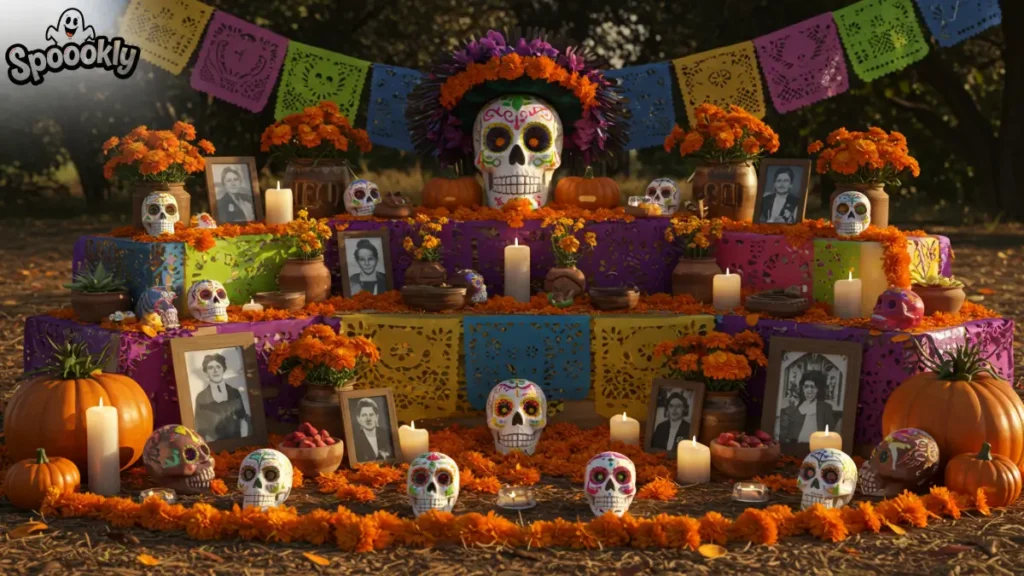
Why These Symbols Matter Today
Halloween symbols do more than decorate our homes, they connect us to emotion, memory, and culture.
- They tap into deep fears like death, the dark, and the unknown.
- They stir nostalgia, reminding us of childhood joy and scary stories.
- They build community, through shared customs, costumes, and storytelling.
From a practical view, these symbols are also powerful marketing tools. Retailers, content creators, and brands use them in ads, products, and social media to catch attention and boost engagement.
Conclusion
Halloween isn’t just about fright, it’s about connection, story, and reflection. From the flicker of a jack-o’-lantern to the rustle of scarecrow straw, every icon whispers an old truth.
These symbols matter because they carry meaning. Meaning that evolves with us.
So the next time you light a pumpkin or hang a bat cut-out, remember you’re part of a tradition centuries in the making.
Which Halloween symbol do you find most powerful or most unsettling?
Let me know in the comments.
And if you enjoyed this guide, don’t forget to share it or pin it for your spooky-loving friends!
FAQs
They originated from Irish traditions of carving turnips to ward off evil spirits. In America, pumpkins replaced turnips due to availability and size.
Both. Many symbols have roots in Pagan and Christian rituals, evolving into cultural icons over time.
Apotropaic marks, bloody handprints, and Mischief Night traditions are often overlooked but hold deep meaning.
Yes, but respectfully. Explain their meaning if you’re using elements like sugar skulls or pagan rituals.

